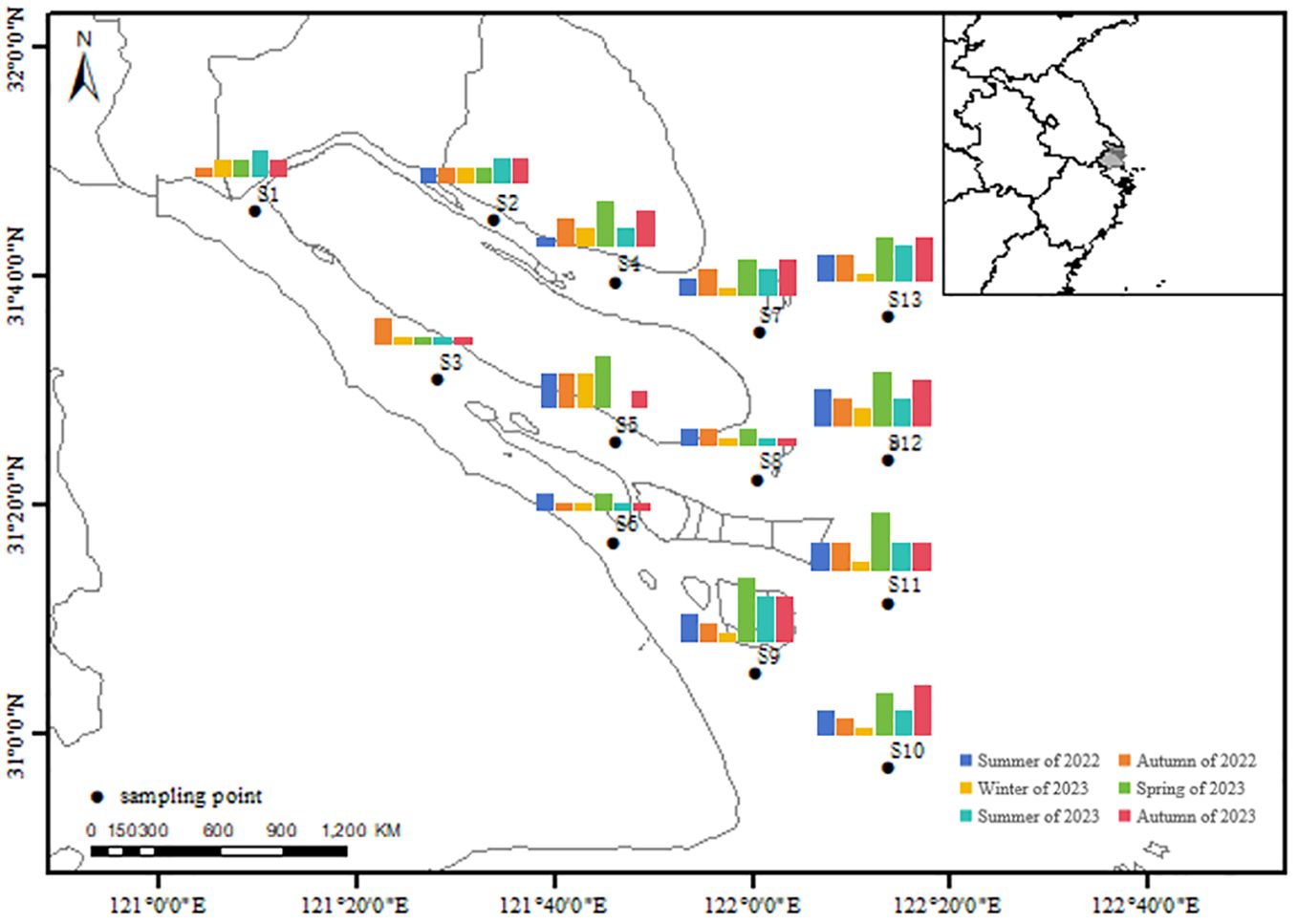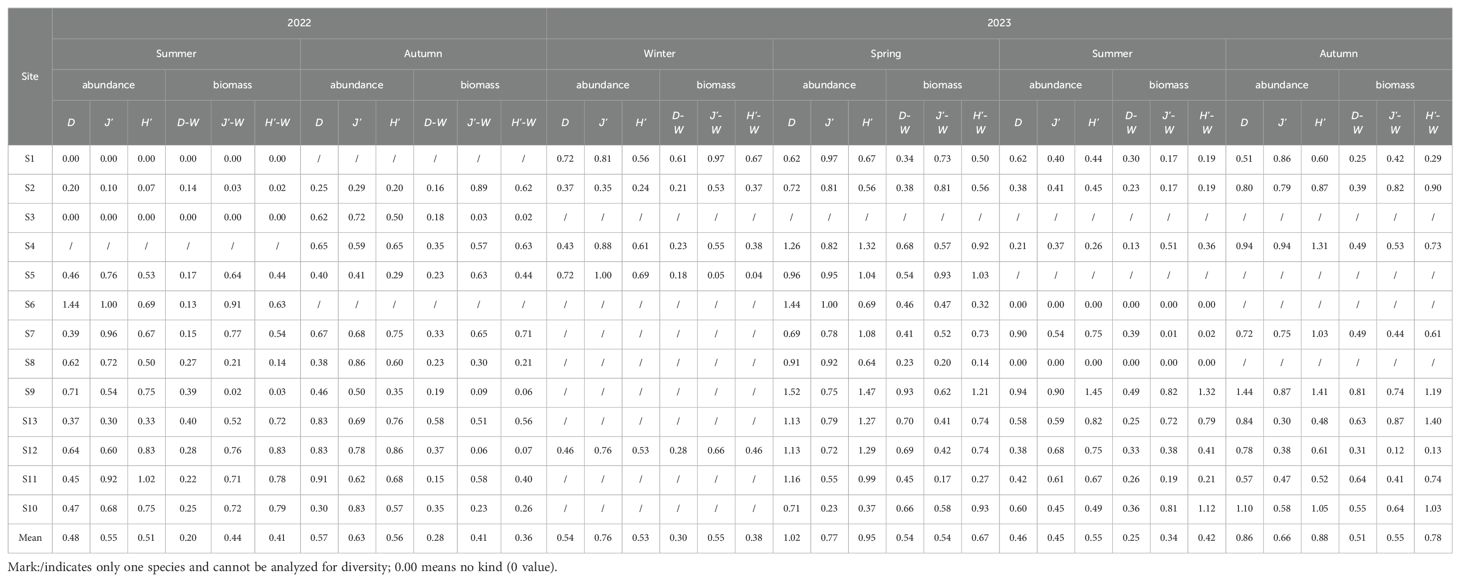- 1East China Sea Fisheries Research Institute, Chinese Academy of Fishery Sciences/Shanghai Engineering Research Center of Fisheries Resources Enhancement and Ecological Restoration of the Yangtze Estuary, Shanghai, China
- 2Key Laboratory of Animal Genetics, Breeding and Reproduction in the Plateau Mountainous Region; Laboratory of Fishery Resources and Environmental Protection, College of Animal Science, Guizhou University, Guiyang, China
The Yangtze River Estuary is the traditional habitat of fishery resources in China and also one of the crab fishing sites, but nowadays the crab resources have been seriously affected by high-intensity anthropogenic disturbance. To understand the composition and diversity of crab community following the fishing ban, six surveys were conducted from August 2022 to November 2023 using the single-bag trawl method. This study examined the crab community composition, biodiversity, resource density, spatiotemporal distribution patterns, and main influencing factors. Results indicated that a total of 14 crab species lived in the Yangtze River Estuary. Matuta planipes and Portunus trituberculatus were dominant crabs in summer 2022. P. trituberculatus, Eriochier leptognathus, and Charybdis japonica were dominant crabs in autumn 2022. Then, E. leptognathus and Eriocheir sinensis were dominant crabs in winter 2023. Notably, the largest numbers of dominant crabs appeared in spring 2023, including M. planipes, P. trituberculatus, E. leptognathus, C. japonica, and E. sinensis. Three same dominant crabs (M. planipes, P. trituberculatus, C. japonica) were identified in the summer and autumn of 2023. Thereinto, P. trituberculatus was the most dominant crab. The abundance and biomass trends of estuary crabs were winter< spring< autumn< summer. The community diversity index, evenness index, and richness index were winter< summer< autumn< spring, indicating the seasonal changes in abundance, biomass, and biodiversity. Correlation and redundancy analysis revealed that dissolved oxygen and salinity were the most critical environmental factors, which affect the changes in crab community in the estuary. This study revealed the changing characteristics of crab resources in the Yangtze River Estuary after the fishing ban, and provided the essential data and scientific basis for resource conservation and management decisions.
1 Introduction
Estuaries harbor abundant biological resources, which are crucial for supplementing marine living resources and maintaining ecological balance (Luo, 1992; Sun et al., 2015). The Yangtze River Estuary, the largest estuary in the western Pacific, supports various economically and ecologically important species, serving as a key area for spawning, foraging, and rearing seedlings (Kindong et al., 2021; Luo, 1992). Key crab species, including Portunus trituberculatus (Yue et al., 2021), Eriocheir sinensis (Shen et al., 2023), and Charybdis japonica (Zheng, 2015), contribute significantly to the biodiversity of the Yangtze River Estuary. However, the extensive exploitation of estuarine resources and large-scale hydroelectric projects have put unprecedented pressure on estuarine ecosystems and marine biodiversity, with studies showing that fisheries catch after the year 2000 was only 8% of what it was in the 1880s (Jin et al., 2009). The Yangtze River Estuary, near the megacity of Shanghai, has faced increased pressure from human activities such as seawall construction, introduction of invasive species, overfishing, sewage discharge, urban development, and agriculture (Zhang et al., 2023). Consequently, there has been a significant decline in fishery resources and biodiversity in the Yangtze River Estuary over the past few decades. Fish diversity in the Yangtze River basin alone declined by an astonishing 38.1%, with no details reported for crabs (Liu and Wang, 2010). China has implemented important conservation plans to protect the aquatic biological resources of the Yangtze River basin. Measures include stocking and releasing aquatic species, habitat restoration, and a 10-year fishing ban on the Yangtze River. Since the 10-year fishing ban was implemented, the aquatic biodiversity has significantly improved. The number of aquatic species has increased by 25 compared to the period before the fishing ban (Information Office of Ministry of Agriculture and Rural Affairs of China, 2023). Since the 21st century, catches in the Yangtze River Estuary have primarily consisted of benthic fish and crustaceans, with crabs increasingly becoming a major target. From 2008 to 2015, there was a dramatic decline in fishery biodiversity in the estuary, with crabs contributing up to one-third of the total catch (Tang et al., 2017). In the summer survey of 2019, the only major crab species identified was the P. trituberculatus (Zheng, 2020). Due to environmental changes and overfishing, resources of crabs, including E. sinensis, have sharply declined.
At present, most research focuses on the community characteristics of aquatic fauna. For example, studies by Li and Chen (2005); Jin et al. (2009), and Sun et al. (2015) analyzed changes in aquatic fauna resources in the Yangtze River Estuary. Especially since the implementation of the fishing ban in the Yangtze River, there has been limited knowledge about the changes in crab resources. Therefore, only comprehensive surveys and research on crabs can enable us to accurately and timely understand the current status of crab communities in the Yangtze River estuary. This study conducted six fishery resource surveys in the Yangtze River Estuary from August 2022 to November 2023. The aim is to analyze the species composition and diversity of crabs following the fishing ban in the Yangtze River estuary. This analysis seeks to evaluate the ecological restoration status of the estuary, protect biodiversity, and provide data support for sustainable fisheries management.
2 Materials and methods
2.1 Survey area and time
In August 2022 (summer), November 2022 (autumn), February 2023 (winter), May 2023 (spring), August 2023 (summer), and November 2023 (autumn), 13 stations have been established at the Yangtze River Estuary (Figure 1). At the same time, a provisional fishing certificate was obtained and fisheries resources survey was conducted on six voyages. The trawl survey has the characteristics of high fishing efficiency, strong adaptability, and flexibility. so the single bag bottom trawl vessel trawl collection, the trawl working time standard is 30 minutes at each station, and the tow speed is 4 kn.
After collecting the caught crabs on-site, they were frozen and stored at -20°C before being returned to the laboratory. The samples were identified and classified using the book “Macrobenthic Invertebrates of the Yangtze River Estuary.” Subsequently, they were weighed, counted, and analyzed biologically. Environmental factors were measured at each station while trawling, using a water sampler to obtain bottom water samples and YSI ProDSS multi-parameter water quality instruments to measure temperature, dissolved oxygen, salinity, and PH. Chlorophyll a was determined by spectral analysis, and water depth and other environmental hydrological data were obtained by the sounder of a fishing vessel (Table 1).
2.2 Statistical analysis of data
2.2.1 Estimation of resource intensity
We adopted the swept area method to estimate fishery resource density using trawl catch (weight and number of individuals) and trawl swept area at each station (Ma et al., 2022). The formula is:
Where: ρi is the resource density at station i (weight: kg/km²; individuals: 10³ ind./km²). Ci is the hourly trawl catch at station i (weight: kg/h; individuals: ind./h). ai is the hourly sweep area of the net gear at station i (km²/h). q is taken as 0.5.
2.2.2 Determination of dominant species
The Index of Relative Importance (IRI) was used to determine the dominant species (Ma et al., 2022):
Where: IRI represents the relative importance index, N is the percentage of the number of individuals of a species to the total number of individuals. W is the percentage of the weight of the species to the total weight. F is the percentage of the number of stations where a species occurs to the total number of stations surveyed. Species with IRI > 500 are classified as dominant, those with 100 ≤ IRI< 500 as important, and species with 10 ≤ IRI< 100 are categorized as common.
2.2.3 Species diversity
The diversity characteristics of crabs were analyzed using the Shannon-Wiener index (H′), Pielou evenness index (J′), and Margalef richness index (D) (Morris et al., 2014).
Shannon-wiener diversity index H′:
Pielou uniformity index J′:
Margalef richness index D:
Where: H′ represents the species diversity index. H′max is the maximum species diversity index. Ni is the number of species i. N is the total number of species. Pi is the proportion of species ii relative to the total number of individuals. S is the total number of species. Inter-seasonal differences in diversity parameters were assessed using independent samples t-tests with SPSS 20.0.
2.2.4 Correlation and redundancy analyses
Pearson correlation analysis was conducted using Origin 2021 software. The crab community index data were analyzed using detrended correspondence analysis (DCA). CCA analysis with the linear model was used in this study to examine the correspondence between environmental factors and resource density for each season from August 2022 to November 2023 (Hammer, 2000).
Survey station maps, resource density planimetry, and diversity index maps were generated using ArcGIS 10.8 software. Dominance calculations were executed in Microsoft Excel 2010. The Shannon-Wiener diversity index, Pielou species evenness index, and Margalef species richness index were computed for each station using the multivariate statistical software PRIMER 6.0 (Hajializadeh et al., 2022). Pearson correlation plots were created with Origin 2021 software, while redundancy analysis (CCA) was performed using Canoco 5.0 software to investigate the relationships between environmental factors and community parameters (Hammer, 2000).
3 Results
3.1 Changes in the number of crab species in the Yangtze River Estuary
3.1.1 Species number composition of crabs
A total of 14 crab species were collected during trawl surveys in the Yangtze River Estuary, representing 9 families of Decapoda (Crustacea) (Table 2). Among these, Five species from the Portunidae family were the most abundant, comprising 35.71% of the total crab species. Calappidae and Porcinidae families have two species, each accounting for 14.26% of the crab species. The remaining crab species belonged to the families Grapsidae, Varunidae, Daninidae, Ocypodidae, and Leucosiidae.
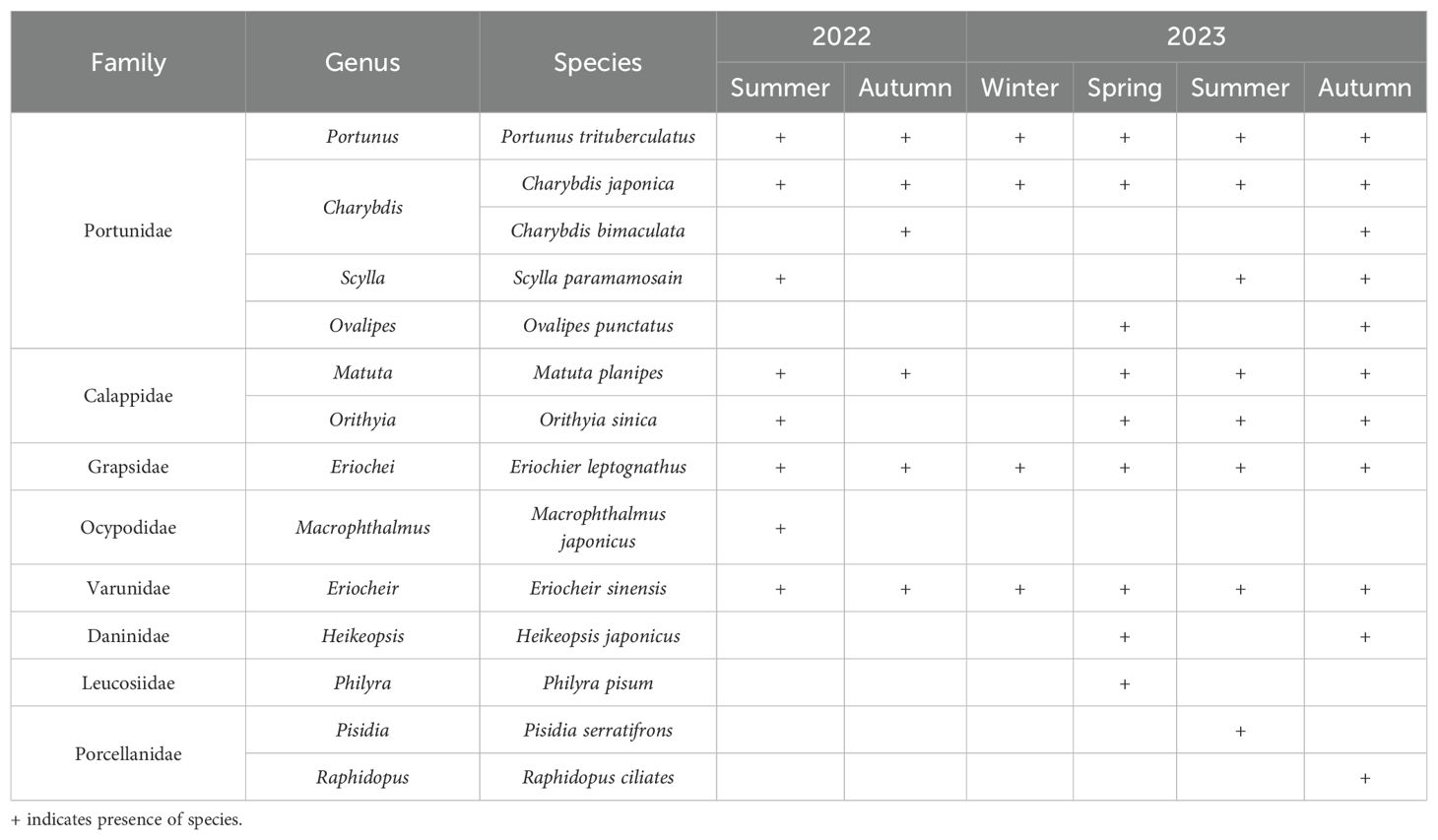
Table 2. Species lists of estuary crab communities in the Yangtze River Estuary from August 2022 to November 2023.
Species observed throughout the year included E. sinensis, Eriochier leptognathus, P. trituberculatus, and C. japonica. In the summer and autumn of 2022, eight and six crab species were captured, respectively. In the winter and spring of 2023, four and nine species were captured. The numbers increased again in the summer and autumn of 2023, with eight and eleven crab species captured, respectively. Overall, the number of crab species exhibited slight seasonal variation.
3.1.2 Spatial distribution of species populations
The biodiversity across different stations varied significantly throughout the seasons. In the summer of 2022, station S12 had the highest species count at 4, while stations S1 and S2 had none. During autumn 2022, species counts ranged from 1 to 3. Similarly, in winter 2023, counts varied from 1 to 2 across all stations. In spring 2023, station S9 had the highest count at 7, while station S3 recorded only 1 species. In the summer of 2023, station S9 recorded 5 species, with no crabs found at station S5. In autumn 2023, station S10 recorded 6 species, while stations S3, S5, S6, and S8 each had only 1 species (Figure 2). The number of crab species reached 5 or more at several stations in different seasons, and it is noteworthy that no crab was detected at certain stations during specific seasons (Figure 2).
3.2 Changes in abundance and biomass of crabs
3.2.1 Variation in species composition of abundance and biomass
In the summer and autumn of 2022, crab abundance was dominated by P. trituberculatus, comprising 51.08% and 64.19% of the total, followed by M. planipes and E. leptognathus at 41.89% and 25.33% respectively. Biomass data indicated that P. trituberculatus accounted for 63.76% and 69.34%, with S. paramamosain and C. japonica following at 19.45% and 16.62%. The abundance and biomass of other crab species were relatively small (Table 3). Analysis of crab abundance throughout the 2023 seasons revealed the following highest proportions: 89.74% for the E. leptognathus in winter, 63.05% for P. trituberculatus in spring, 52.4% for P. trituberculatu in summer, and 52.64% for Matuta planipes in autumn. The next highest proportions were 5.13% for E sinensis in winter, 13.74% and 37.05% for M. planipes in spring and summer, and 25.87% for P trituberculatus in autumn, respectively. Biomass showed the highest proportions: 70.41% for E. sinensis in winter, and 73.02%, 75.91%, and 46.97% for P. trituberculatus in spring, summer, and autumn, respectively. The next highest proportions were 15.74% for C. japonica in winter, 16.12% for E. sinensis in spring, and 9.30% and 23.26% for P. trituberculatus in summer and autumn, respectively. The proportions of other crab species in terms of abundance and biomass were relatively small (Table 3).

Table 3. Resource density (abundance, biomass) and percentage composition of crab catches in the Yangtze River Estuary during 2022-2023.
In the summer and autumn of 2022, crab abundance was 10.88 × 10³ ind./km² and 3.40 × 10³ ind./km², while biomass was 296.12 kg/km² and 46.81 kg/km², respectively. Among the crabs, P. trituberculatus had the highest abundance and biomass, with 5.56 × 10³ ind./km², 2.18 × 10³ ind./km², and 182.41 kg/km², 32.46 kg/km², respectively (Table 3). In the summer and autumn of 2023, abundance and biomass were 16.23 × 10³ ind./km² and 8.18 × 10³ ind./km², and 431.33 kg/km² and 95.44 kg/km², respectively. The highest abundance was found in P. trituberculatus and M. planipes, with 8.56 × 10³ ind./km² and 4.30 × 10³ ind./km² (Table 3). The highest biomass of P. trituberculatus was 327.40 kg/km² and 44.83 kg/km², respectively. In winter 2023, the abundance and biomass of crabs were at their lowest, with 2.22 × 10³ ind./km² and 15.57 kg/km², respectively. In spring 2023, both abundance and biomass were higher than in summer and autumn 2022, rapidly increasing to 12.59 × 10³ ind./km² and 242.57 kg/km² (Table 3).
3.2.2 Geographical distribution of abundance and biomass
In the summer and autumn of 2022, the highest crab abundance values were recorded at stations S13 and S9, measuring 7.88 × 10³ ind./km² and 1.17 × 10³ ind./km², respectively. Conversely, the lowest abundance values were observed at stations S6 and S1, with 0.02 × 10³ ind./km² and 0.01 × 10³ ind./km², respectively. Maximum biomass values were also recorded at station S10, at 235.61 kg/km² and 9.27 kg/km², while minimum biomass values were noted at station S6, with 0.00 kg/km² and 0.23 kg/km² (Table 4). Spatially, the pattern of crab abundance and biomass distribution increased from within the estuary to outside the estuary during the summer and autumn of 2022. The elevated numbers of P. trituberculatus and M. planipes significantly contributed to the high abundance and biomass observed primarily in the waters off the estuary (Figures 3, 4). Notably, no crab was captured at stations S1 and S2 in 2022.
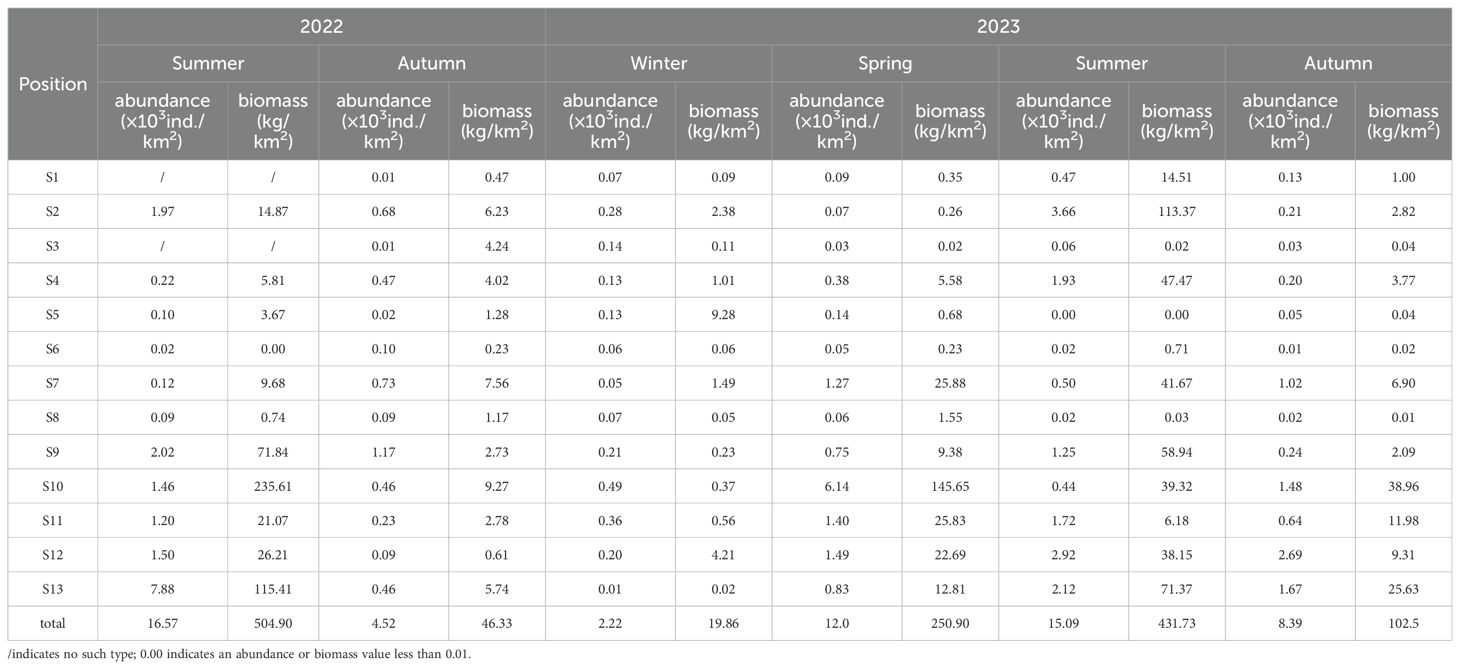
Table 4. Geographical distribution of crab abundance and biomass in the Yangtze River Estuary in different seasons from August 2022 to November 2023.
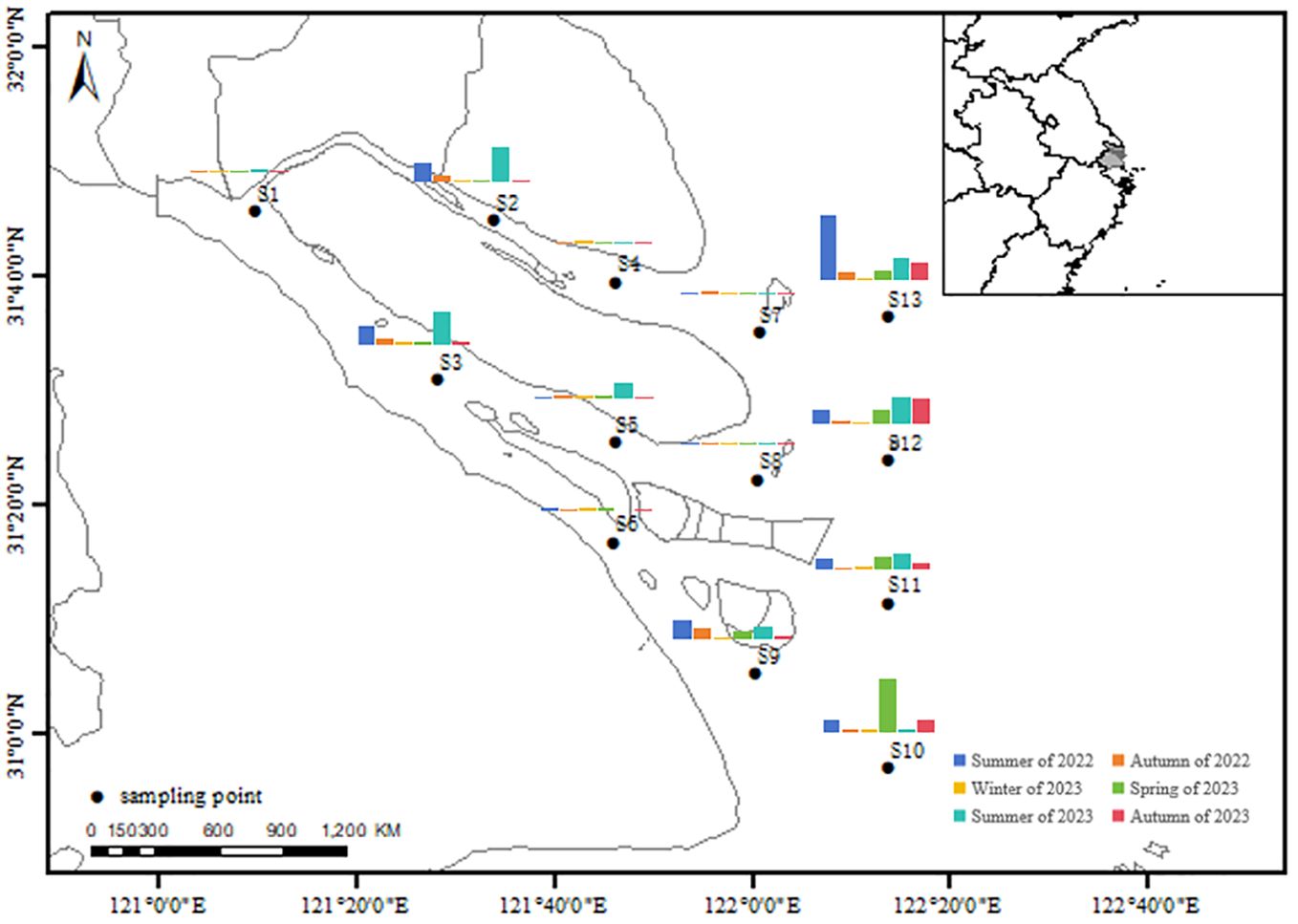
Figure 3. Distribution map of crab abundance in the waters of Yangtze River Estuary in different seasons from August 2022 to November 2023.
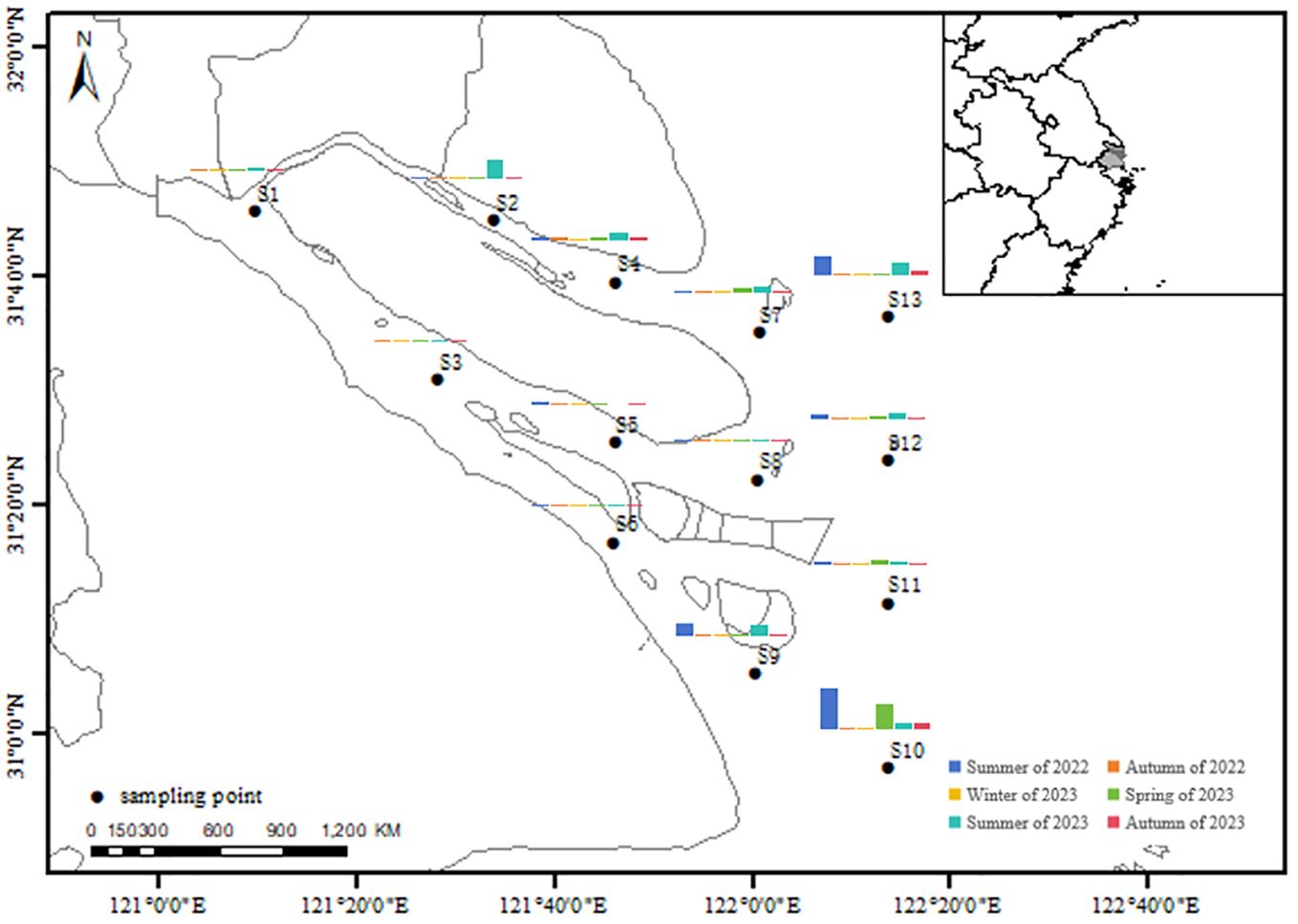
Figure 4. Distribution of crab biomass in the Yangtze River Estuary in different seasons from August 2022 to November 2023.
During the winter and spring of 2023, the distribution of crab abundance and biomass was notably uniform in winter, primarily due to a limited number of perennial crab species in the Yangtze River Estuary, including E. sinensis and C. japonica (Table 4, Figures 3, 4). In spring, abundance distribution was generally consistent, except at station S10, which exhibited significant fluctuations, recording an abundance of 6.14 × 10³ ind./km². Biomass was also elevated near station S10 due to a large presence of P. trituberculatus, affecting both abundance and biomass distribution (Table 4, Figures 3, 4). In the summer and autumn of 2023, the highest abundance values were recorded at stations S2 and S12, with 3.66 × 10³ ind./km² and 2.69 × 10³ ind./km², respectively. The lowest abundance values were at stations S5 and S6, with 0.00 × 10³ ind./km² and 0.01 × 10³ ind./km², respectively. Maximum biomass values were noted at stations S2 and S10, with 113.37 kg/km² and 38.96 kg/km², respectively (Table 4). During this period, abundance and biomass were generally higher, with significant catches of P. trituberculatus at stations S2, S4, and S12 in summer, and large numbers of M. planipes at stations S12 and S13. In autumn, the substantial catches of P. trituberculatus were recorded at stations S10 and S11, while M. planipes were abundant at stations S12 and S13 (Table 4, Figures 3, 4). Overall, the trend in crab abundance and biomass in the Yangtze River Estuary followed the pattern: winter< spring< autumn< summer.
3.3 Dominant crab species in the Yangtze River Estuary
According to the relative dominant species index (IRI), the dominant crab species in the summer of 2022 were M. planipes and P. trituberculatus. In autumn, the dominant species shifted to E. leptognathus, C. japonica, and P. trituberculatus (Table 5). P. trituberculatus exhibited the highest dominance in both summer and autumn, being absent only from stations S1 and S3 in summer, and from stations S1, S3, S5, and S6 in autumn. Maximum abundance occurred at station S2, with 1.94 × 10³ ind./km² in summer and 0.67 × 10³ ind./km² in autumn. The maximum biomass was observed at station S10, with 124.76 kg/km² in summer and 8.01 kg/km² in autumn.
In winter 2023, the dominant species were E. leptognathus and E. sinensis. In spring, the dominant species included M. planipes, Matuta planipes, C. japonica, P. trituberculatus, and E. sinensis (Table 5). E. leptognathus exhibited maximum dominance in winter, while P. trituberculatus showed its highest dominance in spring. During winter, E. leptognathus was absent only at station S7, and during spring, P. trituberculatus was not found at stations S3 and S6. E. leptognathus had the highest abundance at station S2 with 0.26 × 10³ ind./km², while P. trituberculatus reached its peak abundance at station S10, with 5.67 × 10³ ind./km². E. leptognathus reached its maximum biomass at station S11, with 0.45 kg/km², while the P. trituberculatus ‘s maximum biomass was at station S10, with 137.01 kg/km².In the summer and autumn of 2023, the dominant species were M. planipes, P. trituberculatus, and C. japonica (Table 5). P. trituberculatus exhibited the highest dominance during both summer and autumn, being absent only from stations S3 and S5 in summer, and from stations S1, S3, S5, and S6 in autumn. The highest abundance of P. trituberculatus was observed at stations S2 and S10, with 3.22 × 10³ ind./km² and 0.91 × 10³ ind./km², respectively. The maximum biomass of P. trituberculatus was recorded at stations S2 and S10, with 108.93 kg/km² and 29.04 kg/km², respectively.
3.4 Planar distribution of crab community indices
In summer 2022, the mean values of H’, J’, and D’ were 0.51, 0.55, and 0.48 respectively. The mean values for H’-W, J’-W, and D-W, the mean values were 0.41, 0.44, and 0.20. By autumn 2022, these mean values increased to 0.56, 0.63, and 0.57 for H’, J’, and D’, respectively, with corresponding mean values for H’-W, J’-W, and D-W being 0.36, 0.41, and 0.28 (Table 6). During summer, the H’ and H’-W values of crabs varied significantly across different stations, primarily due to zero values at stations S1 and S3, and lower values at station S2. In autumn, the H’ and H’-W values were more evenly distributed among stations. In 2023, significant seasonal variations were observed in the mean values of H’, J’, and D for crabs. During winter and spring, H’ values ranged from 0.53 to 0.95, J’ values ranged from 0.76 to 0.77, and D values ranged from 0.54 to 1.02. In contrast, summer and autumn showed different ranges: H’ values varied between 0.51 and 0.55, J’ values ranged from 0.45 to 0.66, and D values varied from 0.46 to 0.86. The H’ and H’-W values displayed little variation between stations during winter and spring, indicating a uniform distribution. Some stations only captured one crab species, making comprehensive diversity analysis impossible. In summer and autumn, the H’ and H’-W values were more evenly distributed among stations, with zero values observed only at stations S6 and S8 in summer. In autumn, only one crab species was caught at some stations. These findings underscore the dynamic seasonal changes in the physiological parameters of crabs. Overall, the H’, J’, and D values of crabs in the Yangtze River estuary followed the trend: winter< summer< autumn< spring.
3.5 Correlation analysis between community indices and environmental factors
The study examined the relationships between community abundance, biomass, and diversity indices (D, J’, H’, D-W, J’-W, H’-W) and environmental factors such as SBT, DO, SBS, PH, Chl-a, and depth (Figure 5). Pearson’s correlation analyses revealed significant negative correlations between crab abundance and biomass with dissolved oxygen and salinity, while these environmental factors were positively associated with some community indices.
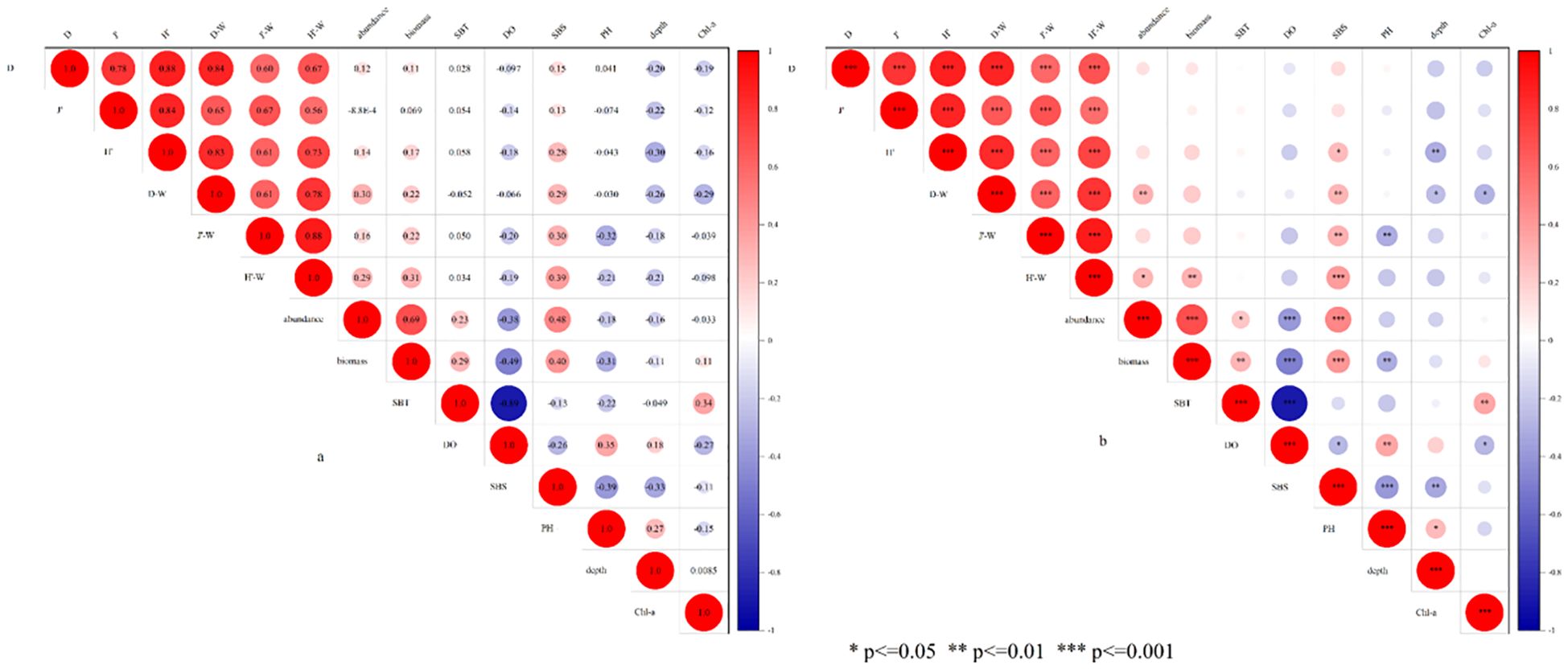
Figure 5. Correlation analysis of ecological index and environmental factors of crab community in Yangtze River Estuary. (A) Relevance; (B) Significance level.
The impact on the crab community is often influenced by multiple environmental factors working together. Therefore, we used the multivariate statistical method Canonical Correspondence Analysis (CCA) to analyze the influence of environmental factors on the crab community index in the Yangtze River Estuary (Figure 6). The CCA analysis found that the first eigenvalue (CCA1) was 0.136, explaining 34.62% of the variance, while the second eigenvalue (CCA2) was 0.103, explaining 2.62% of the variance. Collectively, the first two axes accounted for 37.24% of the relationship between the crab community index and the environmental factors, with strong correlation coefficients of 0.6561 and 0.5387 for the first and second axes, respectively. These findings indicate a robust correlation between the six environmental factors and the crab community index. The study concluded that DO and SBS were the most significant environmental factors affecting the distribution of crab communities in the Yangtze River Estuary. Furthermore, the CCA results were consistent with those obtained from the Pearson correlation analysis.
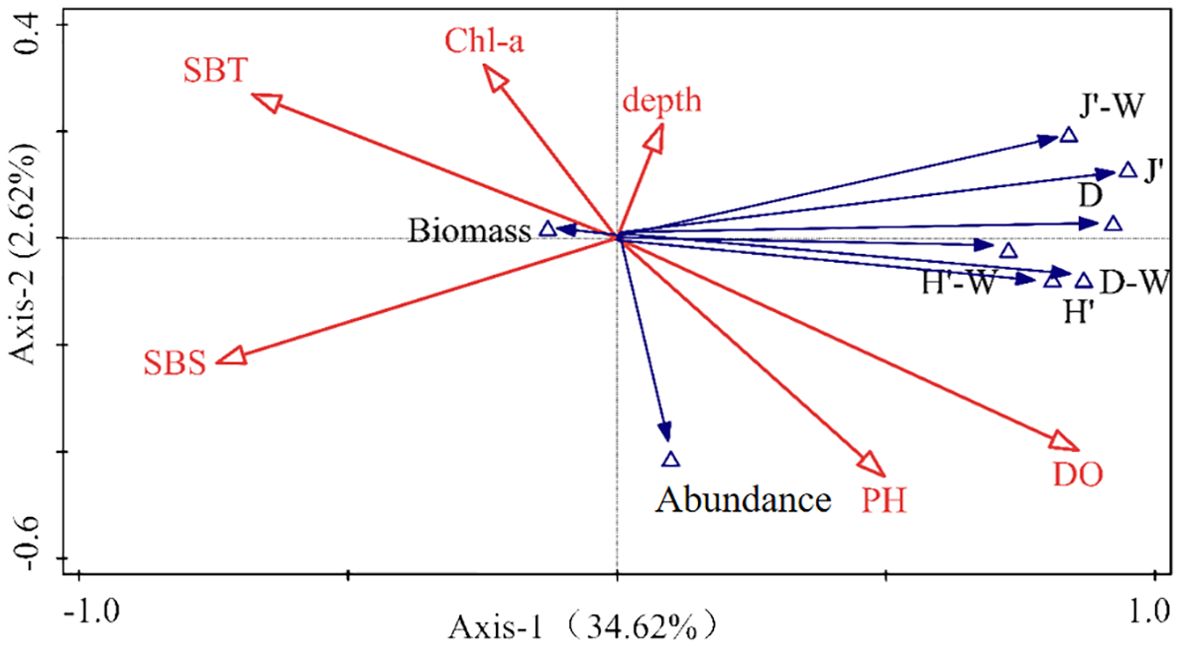
Figure 6. Ranking map of community index of crabs and CCA of environmental factors in Yangtze River Estuary abundance. H’, abundance diversity index; J’, abundance evenness index; D, Abundance refers to the number; H’-W, biomass diversity index; J’-W, biomass evenness index; D-W, Biomass richness index.
4 Discussion
4.1 Analysis of crab species and the composition of dominant species in the Yangtze River Estuary
In this study, a total of 14 crab species were identified during each season from August 2022 (summer) to November 2023 (autumn). These results have surpassed the number of species identified in the 2019-2020 study of the Yangtze River Estuary by Zheng. (2020) and Li (2023) suggesting that the prohibition of fishing in the Yangtze River is beneficial for the recovery of crab resources. There was no significant difference in abundance and biomass in the summer and autumn of 2022 and in the summer and autumn of 2023, and the general trend was winter< spring< autumn< summer. This pattern may be due to crustaceans being short-distance migratory or sedentary species affected by seasonal changes (Zhou and Li, 2018). Additionally, crabs have a short growth cycle, early sexual maturity, high fecundity, and can spawn multiple times during a single period (Yu et al., 2003).
In this study, M. planipes, P. trituberculatus, E. leptognathus, C. japonica, and E. sinensis were the five dominant crab species groups, with the dominant species varying slightly across different seasons. This discrepancy is similar to the findings of Sun et al. (2015) and Jin et al. (2009), who investigated fishery resources in the Yangtze River Estuar and neighboring seas. P. trituberculatus has the widest distribution, the longest duration of occurrence, and the greatest adaptability to seasonal variations in the investigated waters (Jiang et al., 2019; Ma et al., 2022). However, when the food supply is low in winter, P. trituberculatus migrates to the 10-30m deep bottom sediment as water temperatures decrease for overwintering (Song et al., 2023; Tang and Ye, 1990). M. planipes, P. trituberculatus, E. leptognathus, and C. japonica, thrive in warm and saline environment, suggesting that the energy flow and ecological niches of the Yangtze River Estuary ecosystem are mainly influenced by a few species preferring warm and saline conditions. This pattern is similar to the marine life survey in Sanmen Bay (Ma et al., 2022). Among them, mature E. sinensis migrate to offshore waters and estuaries to lay eggs, making estuaries an important spawning ground (Geng, 2018; Geng et al., 2018).
4.2 Spatial and temporal variations in crab biodiversity and resource density in the Yangtze River Estuary
The biodiversity index reflects the spatial heterogeneity of community outcomes and the stability of the community structure (Han, 2020). The H’, J’ and D indices of crabs in the Yangtze River Estuary follow the sequence: winter< summer< autumn< spring. This pattern is similar to findings in the Yangtze River Estuary, the neighboring water areas, and the near-shore water areas of the Shandong Peninsula. Such seasonal variation may be related to environmental conditions and the ecological habits of crabs (Jin et al., 2009; Yang et al., 2017). The Yangtze River Estuary boasts a diverse and complex ecological environment, rich in nutrients and bait organisms, attracting numerous crabs to settle, spawn, and forage (Luo, 1992; Editorial Board of China Bay Survey, 1992). The survey found that most stations with high crab diversity were located where freshwater and seawater meet, as well as estuaries close to the sea.
The trend of abundance and biomass of crabs in the Yangtze River Estuary followed the pattern: winter< spring< autumn< summer, which aligns with the results of crab surveys in Xiamen water areas and Zhejiang offshore water areas (Ding et al., 2019; Zhu, 2023). In winter, few crabs settle in the estuary, with most migrating elsewhere. They return in spring for feeding and rearing. Summer and autumn are peak seasons for crab feeding and breeding, resulting in significant increases in abundance and biomass. The survey found stable crab numbers and biomass year-round, with seasonal variations. This stability could be attributed to the 10-year no-take policy in the Yangtze River, creating a favorable environment. This indicates the success of resource conservation measures by fisheries management authorities.
4.3 Correlation between ecological indices and environmental factors of crab communities in the Yangtze River estuary
Based on the Pearson correlation analysis and CCA analysis results, the primary environmental factors influencing the crab community index were DO and SBS. DO is crucial for the survival of aquatic organisms, especially crabs, impacting their growth, development, and reproduction (Miao, 2021). The levels of DO in the Yangtze River Estuary fluctuate seasonally, with higher levels in summer and lower levels in winter (Li et al., 2024). Seasonal fluctuations in DO levels affect the distribution of zooplankton and bait organisms, which in turn influence crab population distribution (Li et al., 2012; Wang et al., 2016). Changes in DO levels impact the density and behavior of crabs, with higher oxygen levels leading to increased crab density and lower levels resulting in sluggishness and reduced movement, affecting their migration and overall abundance (Gravinese et al., 2020; Vu and Pennings, 2021). Variability in habitats with different DO levels also influences crab migration (Fusi et al., 2017, 2021). Fluctuations in DO levels significantly affect the distribution and habitat selection of aquatic organisms, and together with other environmental factors significantly affect the distribution and habitat selection of aquatic organisms (Cagle et al., 2023; Hernandez and Tapia, 2021).
SBS is another crucial environmental factor impacting the diversity of crab communities in the Yangtze River Estuary. Runoff from the Yangtze River and the mixing of cold water masses in the Yellow Sea and the 7East China Sea result in varying estuarine salinity levels (Jin et al., 2009; Kuang et al., 2022). SBS is an important initiating factor affecting crab development, reproduction, and osmoregulation (Boonsanit and Pairohakul, 2023; Saqib et al., 2023). SBS also plays a significant role in crab spawning, population distribution, and habitat preference (Nesbitt, 2022; Shen et al., 2023). The convergence of freshwater and seawater in the Yangtze River Estuary results in distinct zones characterized by varying SBS levels. The crab community in the Yangtze River Estuary was mainly influenced by DO and SBS, creating a geographical distribution pattern. Lower species numbers, density, and diversity of crabs are found in nearshore areas, while higher crab populations are found on the east, south, and north sides of the estuary, which are less affected by the river’s freshwater flushing.
5 Conclusion
In summary, a total of 14 crab species from 13 genera and 9 families within the subphylum Crustacea were identified in the Yangtze River Estuary. Seasonal collections revealed 8 species in summer 6 in autumn of 2022, and 4 in winter, 9 in spring, 8 in summer, and 11 in autumn of 2023. Dominance patterns showed 2 species in summer and 3 in autumn of 2022, while 2023 exhibited 2 dominant species in winter, 5 in spring, and 3 in both summer and autumn, with P. trituberculatus being the common dominant species across all seasons except winter. The abundance and biomass of crabs exhibited a seasonal trend of winter< spring< autumn< summer, while biodiversity indices (H’, J’, and D) followed a trend of winter< summer< autumn< spring. Notably, the biodiversity of the crab community was primarily influenced by DO and SBS, alongside other environmental factors, shaping the geographical distribution of the crab community in the estuary.
Data availability statement
The original contributions presented in the study are included in the article/supplementary material. Further inquiries can be directed to the corresponding author.
Ethics statement
The animal study was approved by Division of Scientific Research Management, East China Sea Fisheries Research Institute, Chinese Academy of Fishery Sciences. The study was conducted in accordance with the local legislation and institutional requirements.
Author contributions
ZY: Writing – original draft, Investigation, Methodology. GF: Funding acquisition, Writing – review & editing. GY: Investigation, Methodology, Writing – review & editing. TZ: Investigation, Methodology, Writing – review & editing. FZ: Methodology, Supervision, Writing – review & editing. ZG: Investigation, Writing – review & editing. XL: Investigation, Writing – review & editing. QT: Investigation, Writing – review & editing.
Funding
The author(s) declare financial support was received for the research, authorship, and/or publication of this article. This research was supported by the Yangtze River Estuary fishery resources multi-distance cooperative scientific multiplication and release (2021CL03), Ministry of Agriculture and Rural Affairs Government Purchase Service Project (09240251).
Acknowledgments
We are grateful to our colleagues at Laboratory ofEstuarine and Coastal Fishieres Evology for their help with sample sampling and assistance with experiments. Special thanks to colleague Chenchen Shen for the revision of this paper. We would like to express our great appreciation to the editor and the reviewers for their constructive comments on the manuscript.
Conflict of interest
The authors declare that the research was conducted in the absence of any commercial or financial relationships that could be construed as a potential conflict of interest.
Publisher’s note
All claims expressed in this article are solely those of the authors and do not necessarily represent those of their affiliated organizations, or those of the publisher, the editors and the reviewers. Any product that may be evaluated in this article, or claim that may be made by its manufacturer, is not guaranteed or endorsed by the publisher.
References
Boonsanit P., Pairohakul S. (2023). Effects of salinity on physiological responses in the sesarmid crab Episesarma mederi (H. Milne Edwards 1853). Mar. Biol. Res. 19, 480–490. doi: 10.1080/17451000.2023.2282425
Cagle S. E., Roelke D. L., Bhattacharyya J. (2023). A spatially explicit, multi-nutrient, multi-species plankton model for shallow bay systems. Estuar. Coast. 46, 1573–1589. doi: 10.1007/s12237-023-01213-x
Ding P. P., Gao C. X., Tian S. Q., Du X. X., Tang A. J. (2019). Crab community structure and its relationship with environment factors in the offshore waters of southern Zhejiang Province. Mar. Fish. 41, 652–662. doi: 10.13233/j.cnki.mar.fish.2019.06.002
Editorial Board of China Bay Survey (1992). Survey of China Bays Vol. Vol. 5 (Beijing: China Ocean Press).
Fusi M., Babbini S., Giomi F., Fratini S., Dahdouh-Guebas F., Daffonchio D., et al. (2017). Thermal sensitivity of the crab Neosarmatium africanum in tropical and temperate mangroves on the east coast of Africa. Hydrobiologia 803, 251–263. doi: 10.1007/s10750-017-3151-1
Fusi M., Daffonchio D., Booth J., Giomi F. (2021). Dissolved oxygen in heterogeneous environments dictates the metabolic rate and thermal sensitivity of a tropical aquatic crab. Front. Mar. Sci. 8. doi: 10.3389/fmars.2021.767471
Geng Z. (2018). The environment adaptability and conservation strategy of Eriocheir sinensis in estuarine life stages (Shanghai: East China Normal University).
Geng Z., Feng G. P., Zhao F., Zhang T., Yang G., Zhang P. (2018). The application of ultrasonic telemetry in the study of spawning ground of Eriocheir sinensis. Chin. J. Ecol. 37, 3795–3801.
Gravinese P. M., Munley M. K., Kahmann G., Cole C., Lovko V., Blum P., et al. (2020). The effects of prolonged exposure to hypoxia and Florida red tide (Karenia brevis) on the survival and activity of stone crabs. Harmful Algae 98, 101897. doi: 10.1016/j.hal.2020.101897
Hajializadeh P., Safaie M., Naderloo R., Shojaei M. G. (2022). Spatial and temporal distribution of brachyuran crabs in mangroves of the Persian Gulf. Wetlands 42, 490-499. doi: 10.1007/s13157-022-01623-w
Hammer O. (2000). Spatial organization of tubercles and terrace lines in Paradoxides forchhammeri -: evidence of lateral inhibition. Acta Palaeontol. Pol. 45, 251–270.
Han X. F. (2020). Study on community structure and biodiversity of nekton in the conservation zone of spawning ground for Wen-tai fishing ground and nearby waters (Zhoushan: Zhejiang Ocean University).
Hernandez A., Tapia F. J. (2021). Connecting spatial structure in subtidal benthic communities with temporal variability in bottom temperature and dissolved oxygen along an upwelling coast. Estuar. Coast. Shelf S. 250, 107166. doi: 10.1016/j.ecss.2021.107166
Information Office of Ministry of Agriculture and Rural Affairs of China (2023). Yangtze River “ten years of fishing ban” steady implementation, Yangtze River basinThe amount of aquatic biological resources showed a recovery trend. Sci. Fish Farm. doi: 10.14184/j.cnki.issn1004-843x.2023.11.039
Jiang R. J., Zhang L. L., Xu K. D., Li P. F., Xiao W., Fan Z. W. (2019). Characteristics and diversity of nekton functional groups in the coastal waters of south-central Zhejiang Province. Biodivers. Sci. 27, 1330–1338. doi: 10.17520/biods.2019281
Jin X. S., Dan X. J., Guo X. W., Li X. S. (2009). Community structure of fishery biology in the Yangtze River estuary and its adjacent waters. Acta Ecol. Sinica/Shengtai Xuebao 29, 4761–4772.
Kuang C. P., Chen K., Wu Y. L., Wang J. (2022). Response Characteristics of Horizontal Salinity Front to Runoff in the Yangtze River Estuary. Journal of Tongji University(Natural Science) 50, 1458–1470. doi: 10.11908/j.issn.0253-374x.21354.
Kindong R., Chen J., Dai L., Gao C., Han D., Tian S., et al. (2021). The effect of environmental conditions on seasonal and inter-annual abundance of two species in the Yangtze River estuary. Mar. Freshw. Res. 72, 493–506. doi: 10.1071/MF19272
Li S. J. (2023). Study on the Relationship between the Community Structure of Nekton and Environmental Factors in the Southern Water of the Yangtze Estuary in spring and autumn (Shanghai: Shanghai Ocean University).
Li J. S., Chen J. H. (2005). Analysis on the dynamic of fishery biological resources on the fishing grounds of the Changjiang estuary. Mar. Fish. 01, 33–37. doi: 10.3969/j.issn.1004-2490.2005.01.006
Li X. Y., Wang H., Wang Y. Q., Zhang L. J., Wu Y. (2024). Machine learning-based dissolved oxygen prediction modeling and evaluation in the YangtzRiver Estuary. Environ. Sci., 1–05. doi: 10.13227/j.hjkx.202312111
Li K. Z., Yi J. Q., Huang L. M., Huang Z. R., Lin Q., Xiong L. L. (2012). Seasonal variations of bottom nekton in the Lingding Bay of Pearl River Estuary, China. Ecol. Sci. 31, 2–8. doi: 10.3969/j.issn.1008-8873.2012.01.001
Liu X., Wang H. (2010). Estimation of minimum area requirement of river-connected lakes for fish diversity conservation in the Yangtze River floodplain. Divers. Distrib. 16, 932–940. doi: 10.1111/j.1472-4642.2010.00706.x
Luo B. Z. (1992). Ecological characteristics and fishery resources of the Yangtze River Estuary and adjacent sea. Resour. Environ. Yangtze Basin 1, 24–30.
Ma L. K., Chen Q. Z., Chen F. P., Peng X., Chen W. F., Zeng J. N., et al. (2022). Analysis of community structure and biodiversity of nekton in the Sanmen Bay. Oceanol. Et Limnol. Sin. 53, 384–393. doi: 10.11693/hyhz20211000238
Miao Z. (2021). Dissolved oxygen monitoring in pond and hypoxic stress response mechanism of Eriocheir sinensis (Yangzhou: Yangzhou University).
Morris E. K., Caruso T., Buscot F., Fischer M., Hancock C., Maier T. S., et al. (2014). Choosing and using diversity indices: insights for ecological applications from the German Biodiversity Exploratories. Ecol. Evol. 4, 3514–3524. doi: 10.1002/ece3.1155
Nesbitt D. (2022). Wet season variation in mangrove tree crab (Aratus pisonii) population characteristics along a salinity gradient within the Imperial River–Estero Bay watershed (Florida: Florida Gulf Coast University).
Saqib H. S. A., Yuan Y., Kazmi S. S. U. H., Li S., Zheng H., Zhang Y., et al. (2023). Salinity gradients drove the gut and stomach microbial assemblages of mud crabs (Scylla paramamosain) in marine environments. Ecol. Indic. 151, 110315. doi: 10.1016/j.ecolind.2023.110315
Shen C., Wang R., Feng G., Zhuang P., Zhang T., Huang X. (2023). Correlation analysis of migration in Eriocheir sinensis of the Yangtze River estuary based on salinity preference. Environ. Sci. pollut. R. 30, 10724–10732. doi: 10.1007/s11356-022-22850-y
Song C., Wang X. B., Zhang G. H., Han Q. X. (2023). Community characteristics of nekton assemblages in oujiang river estuary and its relationship with environmental factors, zhejiang, East China. Oceanol. Limnol. Sin. 54, 1113–1124. doi: 10.11693/hyhz20221000258
Sun P. F., Dai F. Q., Chen Y. L., Dan X. J., Jin X. S. (2015). Seasonal variations in structure of fishery resource in the Yangtze River estuary and its adjacent waters. Prog. Fish. Sci. 36, 8–16. doi: 10.11758/yykxjz.20150602
Tang Q. S., Ye M. Z. (1990). Development and protection of fishery resources in Shandong coastal waters (Beijing: Agriculture Press).
Tang C. S., Zhang F., Feng S., Dai F. Q., Wang L. T. (2017). Biological community of fishery resources in the Yangtze River Estuary and adjacent sea areas in the summer of 2015. Mar. Fish. 39, 490–499. doi: 10.13233/j.cnki.mar.fish.2017.05.002
Vu H. D., Pennings S. C. (2021). Directional movement of consumer fronts associated with creek heads in salt marshes. Ecology 102, e3447. doi: 10.1002/ecy.3447
Wang J. J., Jiao J. H., Ma D., Chen Y. P., Li C. Q. (2016). Acute toxic effects of reclamed silt and suspended solids on marine organism resources in Tian. Prog. Fish. Sci. 37, 16–24. doi: 10.11758/yykxjz.20150324001
Yang G., Li F., Lv Z. B., Xu B. Q., Yuan X. N., Wang X. X., et al. (2017). Community structure of crabs in the coastal waters along the southern Shandong Peninsula. J. Fish. Sci. China 39, 48–61. doi: 10.3969/j.issn.0253-4193.2017.08.005
Yu C. G., Song H. T., Yao G. Z., Shen X. L. (2003). Study on rational utilization of crab resources in the inshore water of Zhejiang. Mar. Fish. 03, 136–141. doi: 10.3969/j.issn.1004-2490.2003.03.008
Yue L., Wang Y., Zhang H., Xian W. (2021). Stock assessment using the LBB method for Portunus trituberculatus collected from the Yangtze Estuary in China. Appl. Sci. Basel 11, 342. doi: 10.3390/app11010342
Zhang T., Du N., Geng Z., Wang S., Gao Y., Yang G., et al. (2023). Estimation of estuarine habitat degradation and its influence on the reproduction process of the crab Eriocheir sinensis in the Yangtze River Estuary. Ecol. Processes 12, 59. doi: 10.1186/s13717-023-00473-6
Zheng W. (2015). Molecular phylogeography study of Charybdis japonica and Charybdis bimaculata in East China sea and Yellow sea China (Zhoushan: Zhejiang Ocean University).
Zheng W. M. (2020). Analysis of aquatic animals community structure in Hengsha Shoals and adjacent waters of the Yangtze River Estuary and suggestions for management measures (Nanjing: Nanjing Agricultural University).
Zhou Y. D., Li S. F. (2018). Atlas of three main economic categories, one channel and protected area in Donghai District. Beijing. Agric. Press.
Keywords: Yangtze river estuary, crabs, dominant species, diversity, environmental factors
Citation: Yang Z, Feng G, Yang G, Zhang T, Zhao F, Geng Z, Li X and Tan Q (2024) The spatiotemporal changes of crab community in the Yangtze River Estuary after the fishing ban. Front. Mar. Sci. 11:1476392. doi: 10.3389/fmars.2024.1476392
Received: 05 August 2024; Accepted: 30 October 2024;
Published: 20 November 2024.
Edited by:
Yafei Duan, South China Sea Fisheries Research Institute, ChinaReviewed by:
Khor Waiho, University of Malaysia Terengganu, MalaysiaAnglu Shen, Shanghai Ocean University, China
Copyright © 2024 Yang, Feng, Yang, Zhang, Zhao, Geng, Li and Tan. This is an open-access article distributed under the terms of the Creative Commons Attribution License (CC BY). The use, distribution or reproduction in other forums is permitted, provided the original author(s) and the copyright owner(s) are credited and that the original publication in this journal is cited, in accordance with accepted academic practice. No use, distribution or reproduction is permitted which does not comply with these terms.
*Correspondence: Guangpeng Feng, RmVuZ2dwQGVjc2YuYWMuY24=
 Zuchang Yang
Zuchang Yang Guangpeng Feng
Guangpeng Feng Gang Yang1
Gang Yang1 Feng Zhao
Feng Zhao

